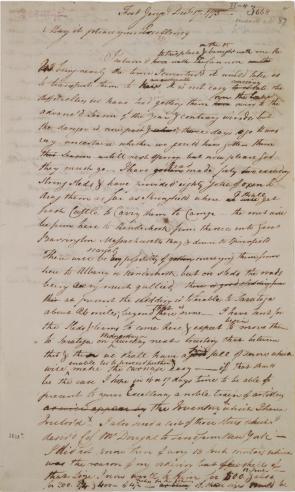Dragging cannon from Fort Ticonderoga to Boston, 1775
A Spotlight on a Primary Source by Henry Knox
 On March 17, 1776, George Washington stood on Dorchester Heights alongside fifty-nine captured cannon high above the city of Boston, Massachusetts, and watched as British troops peacefully evacuated the city after an eleven-month siege.
On March 17, 1776, George Washington stood on Dorchester Heights alongside fifty-nine captured cannon high above the city of Boston, Massachusetts, and watched as British troops peacefully evacuated the city after an eleven-month siege.
It was a remarkable moment for many reasons. The siege had begun in April 1775, in the days after the Revolution’s opening battles at Lexington and Concord, when local militias cut off the peninsular city from surrounding towns. A twenty-five-year-old Continental Army officer and former Boston bookseller named Henry Knox suggested that cannon might be used to drive the British from the town. Washington sent Knox to Crown Point and the recently captured Fort Ticonderoga in northern New York to retrieve fifty-nine cannon and mortars and bring them to Boston.
On December 17, 1775, Knox wrote to Washington from Lake George, New York, describing the difficulty of transporting the cannon and mortars: “It is not easy [to] conceive the difficulties we have had in getting them here over the Lake owing to the advanc’d Season of the Year & contrary winds, but the danger is now past; three days ago it was very uncertain whether we could have gotten them untill next spring, but now please God they must go – I have had made forty two exceeding Strong Sleds & have provided eighty Yoke of oxen to drag them as far as Springfield.”
Knox and his men moved the cannon 300 miles in fifty-six days with the help of oxen and ice sledges and arrived outside Boston on January 25, 1776. When powder for the cannon finally arrived, the Americans began firing on Boston on March 2, and on March 4 mounted the largest guns on Dorchester Heights. British fire couldn’t reach Washington’s forces, and the British loaded their ships and withdrew to Halifax, Nova Scotia, on March 17.
A PDF copy of the letter is available.
A full transcript is available.
Excerpt
I return’d to this place on the 15 & brought with me the Cannon being nearly the time I conjectur’d it would take us to transport them to here, It is not easy [to] conceive the difficulties we have had in getting them over the Lake owing to the advanc’d Season of the Year & contrary winds, but the danger is now past & three days ago it was very uncertain whether we could have gotten them untill next spring, but now please God they must go – I have had made forty two exceeding Strong Sleds & have provided eighty Yoke of oxen to drag them as far as Springfield where I shall get fresh Cattle to Carry them to Camp – the rout will be from here to Kinderhook from thence into Great Barrington Massachusetts Bay & down to Springfield There will scarcely be possibility of conveying them from here to Albany or Kinderhook but on sleds the roads being very much gullied, at present the sledding is tolerable to Saratoga about 26 miles; beyond that there is none – I have sent for the Sleds & teams to come here & expect to begin [to] move them to Saratoga on Wednesday or Thursday next trusting that between this & then we shall have a fine fall of snow which will enable us to proceed further & make the carriage easy – if that should be the case I hope in 16 or 17 days time to be able to present to your Excellency a noble train of artillery.
